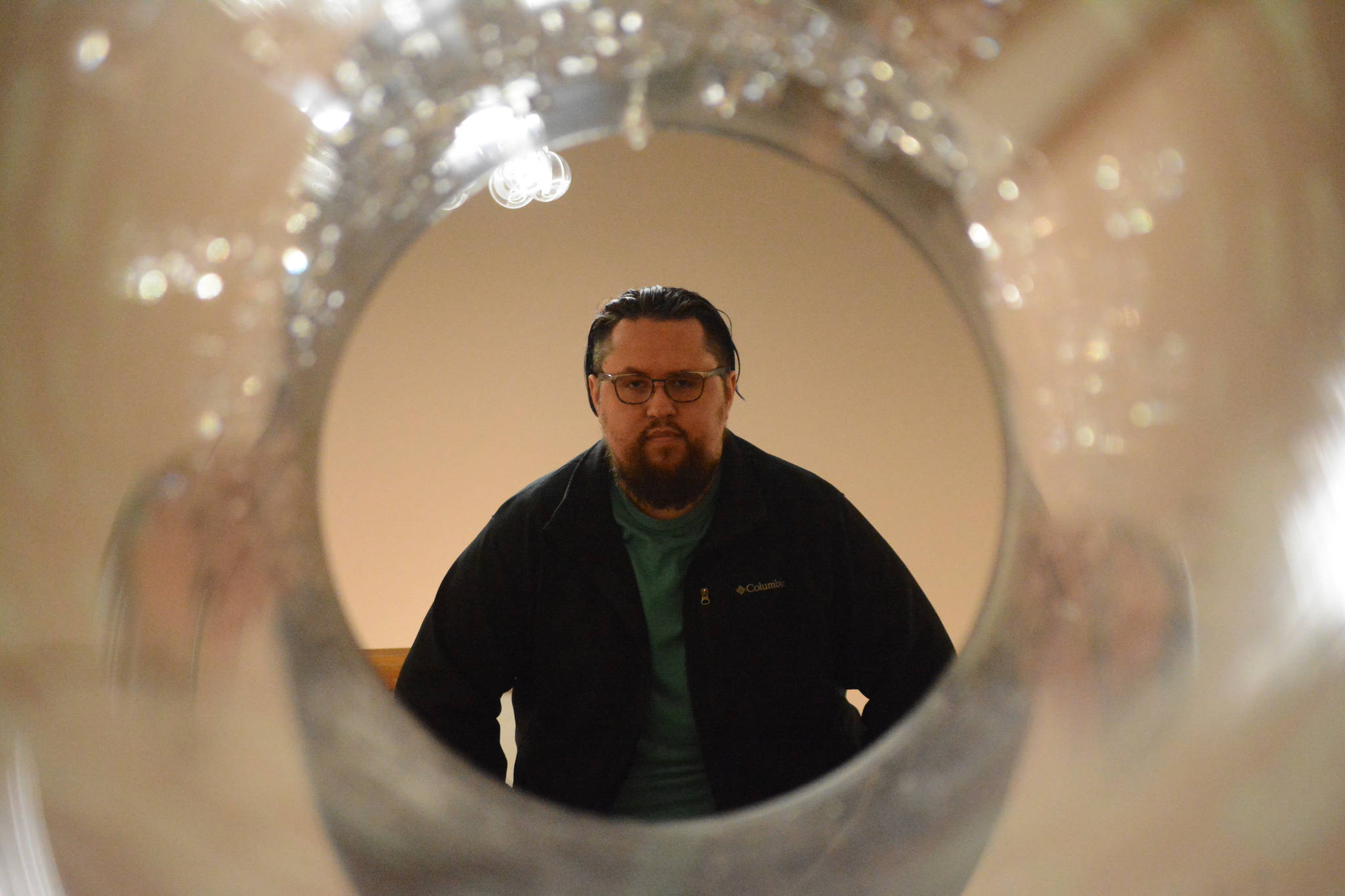In Qena Sint’isis, an exhibit showing through May 26 at the Pratt Museum, artist Argent Kvasnikoff looks at the deeper meaning of language and text. He also reveals a defect of the modern Latin or Roman alphabet, the writing used for many Western languages. Stylized over time, the marks used to show sounds in the Latin alphabet have lost any symbolic meaning — “A” for “ox,” for example, or “O” for “eye.”
Kvasnikoff’s show uses a 44-letter alphabet created by him for sounds from the Dena’ina and other languages. “Qena Sint’isis” uses the Dena’ina word for “word,” “qena,” and the word “synthesis” using Dena’ina phonetics. The show includes that 44-letter alphabet as drawn by Kvasnikoff and pieces exploring the connections between Qena Sint’isis and other images. Central to his piece is a long, plastic tube, “Yaghenen Janju Tets’ Qezhadah,” roughly “the medicine stick of the peninsula’s future.”
“They’re my interpretation of what the symbols are,” Kvasnikoff said of his alphabet. “This is something new. I wanted to make sure people get the visual sense first.”
At 2 p.m. May 5, Kvasnikoff and Érico Vinicius Nascimento of Vancouver, B.C., present “Seeing Language: Writing in Art and Design” at the Pratt Museum. They explore the role of language in art and design and how visual language affects everyday life and personal experience.
Born in Homer, Kvasnikoff, 30, graduated from Ninilchik School and is of the Dena’ina culture. At 13 he began studying art seriously in terms of art history and fine art. At Capilano University, Vancouver, B.C., he studied anthropology and language. In 2010 he moved back to Alaska, working with the Dena’ina indigenous government and social services. He now works as an independent designer and artist.
In Qena Sint’isis, Kvasnikoff said he wanted to show there can be a different background for culture.
“We can be careful and take pride that we have a society based on that old culture,” he said, “You can have an evolving culture.”
As an oral language with no written form, Dena’ina sounds have been transliterated into Latin letters, with diacritical marks added for sounds not found in the Latin alphabet.
“The motivations to create an alphabet for this language included both a desire to share features of the Dena’ina culture through its language using visualization, and also to demonstrate a counterexample of how our everyday Latin alphabet dilutes our experiences of language,” Kvasnikoff writes in a companion book that goes with the exhibit.
Each letter or image in Qena Sint’isis corresponds to a sound, but as Kvasnikoff explains in his book, it also has a story. For example, “uz,” the letter for the sound “u,” looks like a sea star. Its origin comes from Uzintun, the Dena’ina word for the Homer Spit, that means “land extends out place.” The image of a sea star symbolizes the aquaculture of the lower Kenai Peninsula, but it “also represents the spiritual importance of Uzintun as a place where people can seek the guidance of sea spirits,” Kvasnikoff writes.
Some letters also are visual puns. Zhi, the letter for the sound “zh,” comes from the Dena’ina word zhateltish, “there is an echo” that also is the Dena’ina word for “computer.” It also looks like the symbol on a computer for “wi fi” rotated 90 degrees counterclockwise.
Immersed in his alphabet, it’s a system that Kvasnikoff can read easily. Art in his show develops the images of Qena Sint’isis. When discussing one painting, “Naq,” that shows the Big Dipper with words from his alphabet, Kvasnikoff reads the letters smoothly.
Naq is the letter for the sound “n,” and comes from the Dena’ina word “naqaghuqesi” for the Big Dipper —the image of Alaska’s flag as designed by Native artist Benny Benson. As an aside, Kvasnikoff notes that Benson’s Alaska flag design is one of the most well-known examples of Alaska Native art.
The fun in Kvasnikoff’s show comes from looking at the art as visual forms and then as language.
“I want them to see the image first,” he said. “If they’re interested, they can do some decoding. … I want it to be about the visual first and not encoded in the writing.”
Kvasnikoff said Qena Sint’isis is “just a reflection on my take on things.” Artists and writers can create their own visual alphabet, he said.
“I think it’s possible for anyone to make their own if they had enough time,” he said.
Michael Armstrong can be reached at michael.armstrong@homernews.com.
• More photos on page 12 and at HomerNews.Com.


